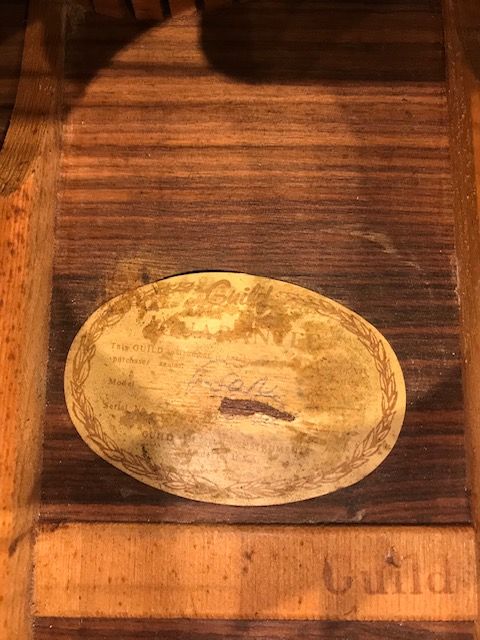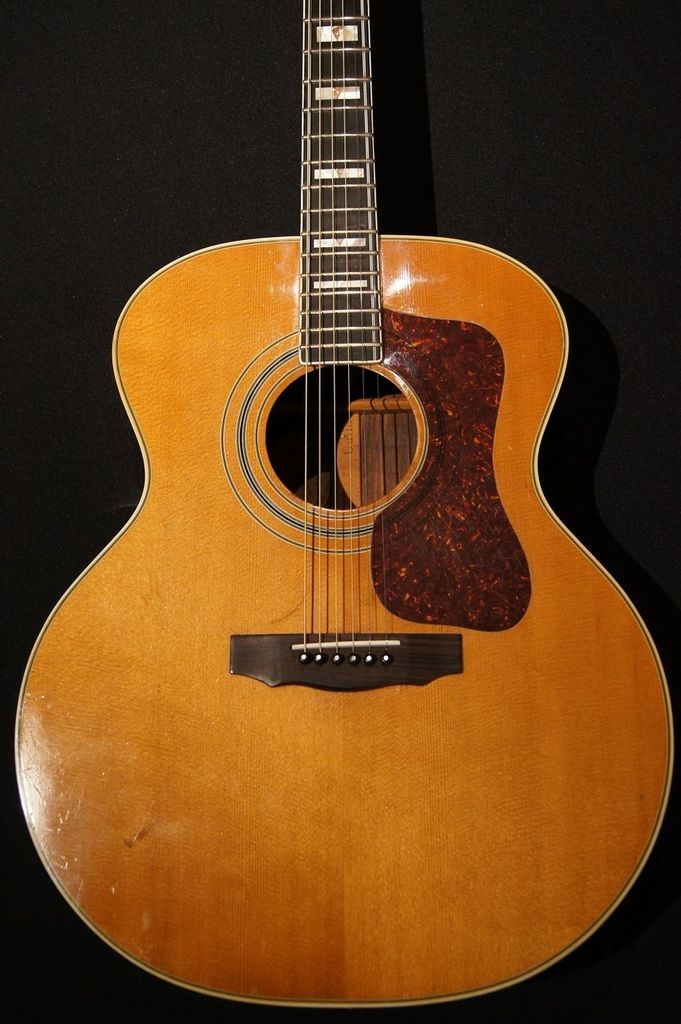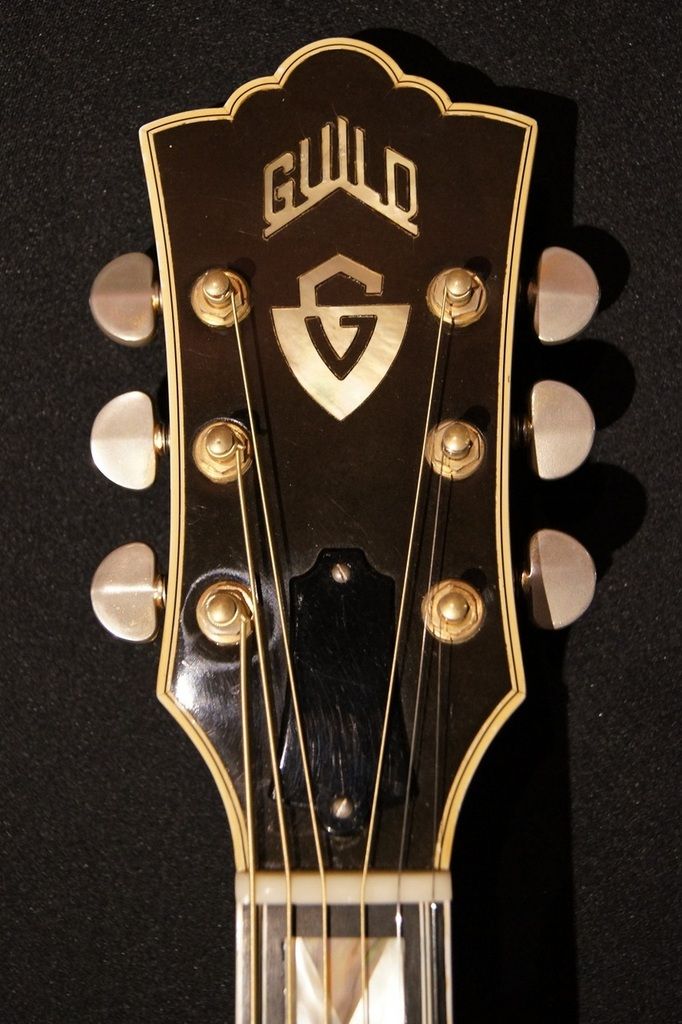You are using an out of date browser. It may not display this or other websites correctly.
You should upgrade or use an alternative browser.
You should upgrade or use an alternative browser.
Is the back of this 1970's Guild F-50 Brazilian rosewood ?
- Thread starter gotomsdos
- Start date
hansmoust
Enlightened Member
And which period(early, middle or late) in 1970's does it fall in ? What's your best guess ?
That's from around 1974.
Sincerely,
Hans Moust
www.guitarsgalore.nl
Guildedagain
Enlightened Member
Nice bod ;-)
Why do some guitars have a metal truss rod cover and some have the plain plastic? Or is this cover wrong for this guitar? I see slotted screws, more than likely incorrect?
Why do some guitars have a metal truss rod cover and some have the plain plastic? Or is this cover wrong for this guitar? I see slotted screws, more than likely incorrect?
adorshki
Reverential Member
To tell you the truth I think the sides are Braz.Here's it:
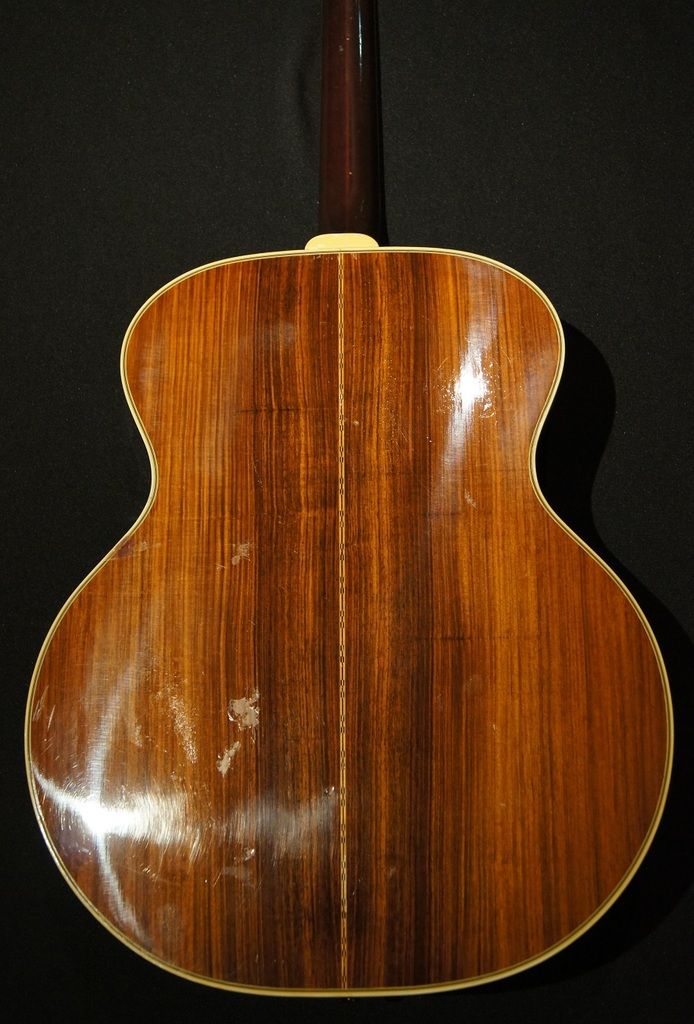
Do you think it's BRW(straight grain) Here's the sideOh, ugly? and looks like EIR?)
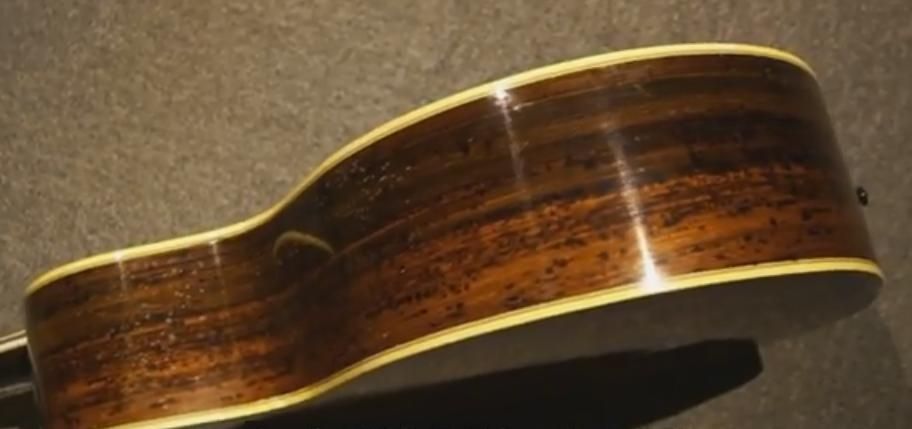
Reminds me of a classical guitar my aunt had in '69, she was very proud of the Brazilian rosewood construction.
Also I think that band by the top shows a little of the greenish tint that Braz can show.
Brazilian was supposed to be highly figured along with the color tells like greens and purples, and EIR was supposed to be boringly straight back in the day.
But we've seen examples of each species showing characteristics of the other type, except maybe for coloring in the EIR.
For that reason Hans Moust himself has mentioned the difficulty of ID'ing the type from photos and normally avoids doing that.
A couple of other issues that have been discussed extensively here before:
There was a period in the early '70's from about '71- '74 when Guild actually shipped guitars with mixed EIR /Braz sides and backs, just like Butch mentioned in post #13, but have seen more D50's built that way than any other model I can recall.
We've seen several examples of those. Latest one I can remember was a '74 D50 confirmed as mixed Braz/ EIR by Hans Moust, according to the owner/member here.
As if they ran out of braz big enough for backs but still had some tock good enough for sides.
I don't ever recall seeing that on F50R's but I think that might be an example of the practice.
By '78 all the Braz big enough for backs AND sides appeared to have been used up for at least 3 years, unless they were keeping a reserve for some reason.
So look how much the back and even the sides on that '78 (which I think can't possibly be braz,) looks like the back on the guitar you're asking about where you think the back is braz.
I think they're both EIR.
To give some reference to you, I'd like to upload the back of another F-50 (rosewood, made in R.I. and 1978 claimed), Here's it:
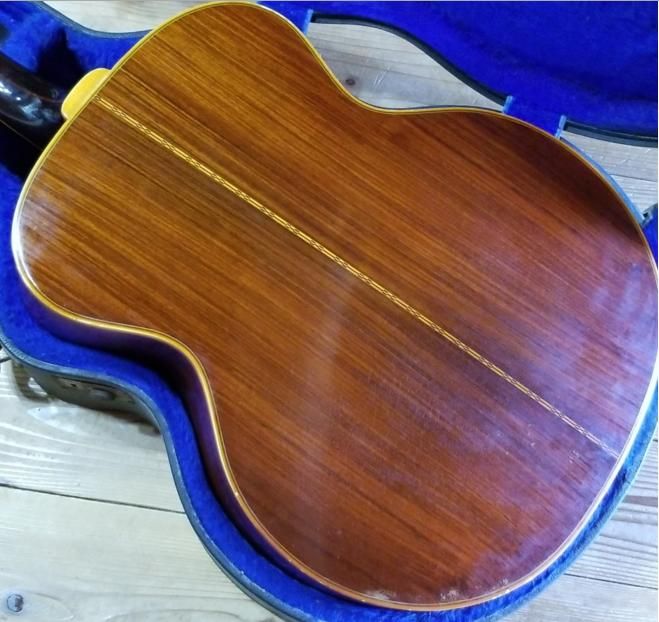

The back looks obviously like EIR.
Any input would be greatly appreciated...
Wish the pic was bigger but here's a shot of Braz showing the black spots:
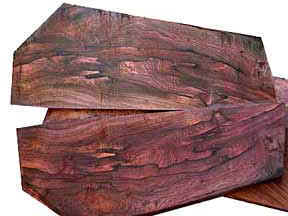
Here' s a shot showing why braz was considered so much more figured that EIR "back in the day" (late '60's):

Plastic came in later but don't remember when, late '70's, I think?.Nice bod ;-)
Why do some guitars have a metal truss rod cover and some have the plain plastic?
Besides being upside down, I think it is wrong for this guitar.Or is this cover wrong for this guitar? I see slotted screws, more than likely incorrect?
Last edited:
adorshki
Reverential Member
The ONLY way to bring a Brazilian rosewood guitar into the country legally right now would be to go to the country where it is, buy it, and personally hand carry it back into the US under the 20 lbs of personal property exemption.I saw the ad for this guitar, and it’s located in Japan. If the sides are Brazilian, which they appear to be, you may not be able to import it. It may not clear customs.
See pg 22 here:
https://www.fws.gov/international/p...appendix-II-timber-listings-December-2016.pdf
wileypickett
Senior Member
To tell you the truth I think the sides are Braz . . . there was a period in the early '70's from about '71- '74 when Guild actually shipped guitars with mixed EIR /Braz sides and backs, just like Butch mentioned in post #13, but have seen more D50's built that way than any other model I can recall.
I agree with adorshki -- sides look more like Brazilian than the back to me too, at least from these photos and my rather limited experience with Brazilian.
My D50 -- repaired by Guild in New Hartford -- was identified as having a Brazilian back (by Kim Keller and the person who did the repair -- forgetting his name) the minute they opened the case. But neither they (nor anyone else they showed the guitar to at Guild) could say for certain if the sides were also Brazilian. Even the experts. . . !
Not sure why that label looks like its been through the war. It's been reattached in a different spot than it was in originally -- maybe glued back in with a glue so strong it seeped through the paper? Or was some amateur work done inside the guitar?
Unless price is no object, I'd evaluate it based on how it sounds and plays and whether it's likely to need expensive repairs anytime soon, rather than on whether it might be Braziian. But that's just me.
Unless price is no object, I'd evaluate it based on how it sounds and plays and whether it's likely to need expensive repairs anytime soon, rather than on whether it might be Braziian. But that's just me.
That's some good advice.
gotomsdos
Junior Member
- Joined
- Jun 27, 2018
- Messages
- 69
- Reaction score
- 0
Great thanks to all you !
Learned a lot !
Does "back in the day" (late '60's) mean GUILD only or all brands of vintage guitars(Martin included?). If it's the former, OIC. But if it's the latter, it's hard to be understood, cause in my limited knowledge, almost all vintage Martins have straight grained BRW back and sides. On the contrary, We almost can hardly see any figured BRW back and sides on vintage Martins, at least very few. And from my very limited knowledge of rosewood, the majority of rosewood(including BRW and even those non rosewood which looks like rosewood, e.g. pau ferro(Alias Bolivian "rosewood"/Santos "rosewood"), if quarter sawn, looks straight(not that figured) while flat sawn, figured, even highly figured. Wonder if I have a wrong recognition.
And I launched the thread primarily because in my eyes the back of the topic guitar(a 1970's Guild F-50R as the 1st pic provided) has an extremely similar grains to that of a vintage Martin. I have an impression(not sure if I'm right) that borderlines between grains(dark and light) on BRW on vintage Martins are far clearer than those on EIR guitars which are vague and hazy.
Learned a lot !
I have a confusion:braz was considered so much more figured than EIR "back in the day" (late '60's):
Does "back in the day" (late '60's) mean GUILD only or all brands of vintage guitars(Martin included?). If it's the former, OIC. But if it's the latter, it's hard to be understood, cause in my limited knowledge, almost all vintage Martins have straight grained BRW back and sides. On the contrary, We almost can hardly see any figured BRW back and sides on vintage Martins, at least very few. And from my very limited knowledge of rosewood, the majority of rosewood(including BRW and even those non rosewood which looks like rosewood, e.g. pau ferro(Alias Bolivian "rosewood"/Santos "rosewood"), if quarter sawn, looks straight(not that figured) while flat sawn, figured, even highly figured. Wonder if I have a wrong recognition.
And I launched the thread primarily because in my eyes the back of the topic guitar(a 1970's Guild F-50R as the 1st pic provided) has an extremely similar grains to that of a vintage Martin. I have an impression(not sure if I'm right) that borderlines between grains(dark and light) on BRW on vintage Martins are far clearer than those on EIR guitars which are vague and hazy.
Last edited:
GardMan
Enlightened Member
Nice bod ;-)
Why do some guitars have a metal truss rod cover and some have the plain plastic? Or is this cover wrong for this guitar? I see slotted screws, more than likely incorrect?
Adorshki said:Plastic came in later but don't remember when, late '70's, I think?.
My '71 D-44 had a metal TRC. Everything I have owned dating from 1972 and later has had the plastic covers. This jives with Hans' comment on p25 of his book that the TRCs were switched to plastic "at the beginning of the 70s"...
Most got the rather generic black plastic TRC mirroring the headstock shape. Some models got laminated TRCs with the model number or name engraved...
fronobulax
Bassist, GAD and the Hot Mess Mods
- Joined
- May 3, 2007
- Messages
- 24,726
- Reaction score
- 8,859
- Location
- Central Virginia, USA
- Guild Total
- 5
Plastic came in later but don't remember when, late '70's, I think?.
A 1971 JS II electric bass came from the factory with a plastic TRC. Until one of us confirms our memory from Hans' book, I'm thinking the overall switch from metal to plastic was 'early '70's'.
Last edited:
adorshki
Reverential Member
Yes I meant late '60's, and it was supposed to be about Brazilian in general, not any specific make.Great thanks to all you !
Learned a lot !
I have a confusion:
Does "back in the day" (late '60's) mean GUILD only or all brands of vintage guitars(Martin included?).
My knowledge was only based on what my aunt told me. She may have been wrong.
You appear to have a lot more acquaintance with Martins from the period so now I understand why you thought those Guilds were Brazilian.
It could be that Martin selected for the straight-grained stuff for their own reasons, but I really don't know.
That's a possibility I didn't even consider, could very well be.If it's the former, OIC. But if it's the latter, it's hard to be understood, cause in my limited knowledge, almost all vintage Martins have straight grained BRW back and sides. On the contrary, We almost can hardly see any figured BRW back and sides on vintage Martins, at least very few. And from my very limited knowledge of rosewood, the majority of rosewood(including BRW and even those non rosewood which looks like rosewood, e.g. pau ferro(Alias Bolivian "rosewood"/Santos "rosewood"), if quarter sawn, looks straight(not that figured) while flat sawn, figured, even highly figured. Wonder if I have a wrong recognition.
Now I learned something.
Will try to do some further research on the subject, was only looking for images to support my point, yesterday.
I suspect this is probably one of those areas where characteristics can be so similar that telling the difference between 'em isn't truly possible from photos.And I launched the thread primarily because in my eyes the back of the topic guitar(a 1970's Guild F-50R as the 1st pic provided) has an extremely similar grains to that of a vintage Martin. I have an impression(not sure if I'm right) that borderlines between grains(dark and light) on BRW on vintage Martins are far clearer than those on EIR guitars which are vague and hazy.
Also, as mentioned before, it's possible Martin intentionally selected for a certain appearance for their body woods.
I have virtually zilch knowledge about Martin compared to Guild so I don't doubt your observations.
Just offering potential reasons for 'em besides the usual assumptions that it's all about the differences between the species.
As we get to know new members better we can better gauge their experience level either with guitars in general or Guilds in particular, so it's all part of the getting acquainted process.
Which reminds me, I don't ever recall saying "Welcome aboard!" since you signed up about 9 months ago but don't post much.
:friendly_wink:
PS thanks to the guys who narrowed down the plastic TRC introduction timing.
If the Guild Guitar Book were more readily available I'd keep a copy here where I post from in addition to the one I leave safe at home.
:tranquillity:
:smile-new:
EDIT/ADD:
One other thing occurred to me, that perhaps the Martins you've seen are visible (I assume from "for sale" listings"?) because the highly figured examples are more prized by owners and don't get offered for sale?
Don't know what the sources of examples you've seen are, so just "spit-balling".
No knock on Martin but I just don't have enough time to go looking for examples of highly figured backs from 'em.
It also occurred to me that perhaps the considered the straight-grained stuff to me more easily and consistently worked?
(That actually seems like the most likely explanation after considering their production vs QC needs, I'd buy that explanation in a second from somebody I considered a credible source)
Last edited:
gotomsdos
Junior Member
- Joined
- Jun 27, 2018
- Messages
- 69
- Reaction score
- 0
Yes I meant late '60's, and it was supposed to be about Brazilian in general, not any specific make.
My knowledge was only based on what my aunt told me. She may have been wrong.
You appear to have a lot more acquaintance with Martins from the period so now I understand why you thought those Guilds were Brazilian.
It could be that Martin selected for the straight-grained stuff for their own reasons, but I really don't know.
That's a possibility I didn't even consider, could very well be.
Now I learned something.
Will try to do some further research on the subject, was only looking for images to support my point, yesterday.
I suspect this is probably one of those areas where characteristics can be so similar that telling the difference between 'em isn't truly possible from photos.
Also, as mentioned before, it's possible Martin intentionally selected for a certain appearance for their body woods.
I have virtually zilch knowledge about Martin compared to Guild so I don't doubt your observations.
Just offering potential reasons for 'em besides the usual assumptions that it's all about the differences between the species.
As we get to know new members better we can better gauge their experience level either with guitars in general or Guilds in particular, so it's all part of the getting acquainted process.
Which reminds me, I don't ever recall saying "Welcome aboard!" since you signed up about 9 months ago but don't post much.
:friendly_wink:
PS thanks to the guys who narrowed down the plastic TRC introduction timing.
If the Guild Guitar Book were more readily available I'd keep a copy here where I post from in addition to the one I leave safe at home.
:tranquillity:
:smile-new:
EDIT/ADD:
One other thing occurred to me, that perhaps the Martins you've seen are visible (I assume from "for sale" listings"?) because the highly figured examples are more prized by owners and don't get offered for sale?
Don't know what the sources of examples you've seen are, so just "spit-balling".
No knock on Martin but I just don't have enough time to go looking for examples of highly figured backs from 'em.
It also occurred to me that perhaps the considered the straight-grained stuff to me more easily and consistently worked?
(That actually seems like the most likely explanation after considering their production vs QC needs, I'd buy that explanation in a second from somebody I considered a credible source)
Thank you adorshki for giving such a detailed input !
As for the source BRW characteristcs on vintage Martins I mentioned comes from, I've gotta say I'm a bit ashamed, it's all from web pictures players or sellers show, such as UMGF, reverb, gbase, ebay, various sellers on vintage guitars, etc, and those acquired by Google search. I'm not sure. That's why I ask here. But it's great amount. So far I've not seen even a single vintage Martin(pre 1970) with a figured BRW. Perhaps there is, but not to my eyes yet ? Who knows.
Last edited:
GuildFS4612CE
Senior Member
- Joined
- Apr 18, 2007
- Messages
- 3,360
- Reaction score
- 496
I think you guys might be missing a salient point: In the past, when wood was in plentiful supply, straight grain was 'fashionable'...as supplies dwindled, other parts of the logs, less desirable, were used...suddenly, highly figured woods became 'fashionable'...think of the guitar tops...bearclaw used to be considered a flaw...now it's marketed as an asset...guitars still sound great.
And, yes, BRAZ & EIR both appear as straight grain and highly figured...that's why it takes an expert to ascertain for certain exactly what species the wood is.
Overthinking, while fascinating and entertaining, often misses the basics...and sometimes you can't see the forest for the trees.:wink-new: layful::tranquillity:
layful::tranquillity:
And, yes, BRAZ & EIR both appear as straight grain and highly figured...that's why it takes an expert to ascertain for certain exactly what species the wood is.
Overthinking, while fascinating and entertaining, often misses the basics...and sometimes you can't see the forest for the trees.:wink-new:
Last edited:
Butch
Junior Member
Is that a scratch on the back of the neck where the mahogany meets the maple strip or is it a crack? Am I the only one that noticed that?
gotomsdos
Junior Member
- Joined
- Jun 27, 2018
- Messages
- 69
- Reaction score
- 0
Yes, Butch. That is a crack, but the seller says it's a crack of finish only. Who knows. It looks like a crack of wood.Is that a scratch on the back of the neck where the mahogany meets the maple strip or is it a crack? Am I the only one that noticed that?
Butch
Junior Member
It looks like a crack at the seam where the maple and the mahogany are glued together. I would exercise extreme caution. It looks like the crack is right at the end of the truss rod which is a high stress area.
adorshki
Reverential Member
Thanks Jane!I think you guys might be missing a salient point: In the past, when wood was in plentiful supply, straight grain was 'fashionable'...as supplies dwindled, other parts of the logs, less desirable, were used...suddenly, highly figured woods became 'fashionable'...
Ties in with my aunt's guitar being built in late '60's, it was "new" when I saw it in mid-'69, and obviously she was sold on the figuring.
Saw a reference once a long time ago that Martin actually stopped using Braz in '67 but I was never able to confirm it, now it seems possible it was because they couldn't get the straight grain stuff they wanted anymore? (at least, "reliably"?)
Also ties in with my (former) assumption that basically all rosewood from the early '60's was Braz because there was no need to go to EIR yet, and remember being surprised at least once when Hans ID'd an early '60's Guild as actually being EIR.
A classical model, I think?
Just remember being surprised and filing it under "EIR sighting from early '60's"
gotomsdos
Junior Member
- Joined
- Jun 27, 2018
- Messages
- 69
- Reaction score
- 0
Hi, GuildFS4612CEIn the past, when wood was in plentiful supply, straight grain was 'fashionable'...as supplies dwindled, other parts of the logs, less desirable, were used...suddenly, highly figured woods became 'fashionable'..
As to BRW(Brazilian rosewood) back & sides, actually back in the past(prior to 1970), especially Martin (I know very little of other makers like Guild) although figured grains definitely look prettier than straight grains, people wanted straight grain was not because it was "fashionable" but to get wood with high density(the higher the density, the harder they are, the longer the life of a guitar). There were almost no figured BRW back & sides back then. But on the contrary, there are almost no modern non Indian rosewood(BRW, Madagascar rosewood, and Cocobolo rosewood) Martins (at least from 1990's) with straight grains, just figured, sometimes highly figured, just because of too little supply of theses wood.
Last edited:
Guildedagain
Enlightened Member
From the net;
Brazilian Rosewood
Dalbergia nigra
Other Names: Bahia Rosewood, Rio Rosewood, Jacarandá da Bahia, Jacarandá De Brazil, Piano wood, Caviuna, Obuina Drago
Family: Fabaceae
Natural Range: Brazilian Atlantic Forest
IUCN Conservation Status
Vulnerable (VU) Brazilian rosewood - credit Mauricio Mercadante
Brazilian rosewood is endemic to the coastal Brazilian Atlantic Forest, one of the most diverse ecosystems in the world. Of the over 8,000 plants species that grow there, Brazilian rosewood is one of the largest, growing to a height of 40m. It can also be recognised by its dark branches that grow in zigzag patterns and by its feathery leaflets.
The tree is able to withstand a broad range of climatic conditions from tropical lowland forest to sub-montane forest. Nitrogen fixing bacteria and fungi in its roots allows the species to survive in nutrient deficient soils. Throughout a short period between November and December its flowers are pollinated by insects, mainly bees and it produces fruit from January until September.
Like all rosewoods, the species has a strong sweet smell reminiscent of the fragrance of roses. The high oil content of the wood also makes it desirable for use as an essential oil for fragrance cosmetics and for use in medicines.
Its timber is heavy and strong, making it highly resistant to insect attack and decay. It is therefore much sought after in local markets as a building material for use in flooring, structural beams and wall panelling/lining. Worldwide, its timber, being highly resonant, is also used to make musical instruments.
Brazilian rosewood is threatened by illegal logging and habitat loss. Today, the Brazilian Atlantic Forest retains just 7% of its original cover and the Brazilian rosewood now only occurs in fragmented, small populations with low genetic variability in the Brazilian states of Bahia, Minas Gerais, Espırito Santo, Rio de Janeiro and Sao Paulo. Furthermore, the regeneration of this species may be limited, possibly as a result of high seed predation by rodents.
In 1992, in response to the threat of logging, Brazilian rosewood became one of the first ever tree species to be listed on Appendix 1 of CITES, prohibiting international trade in the timber or other products from this species. Despite its inclusion the species continues to be illegally logged and traded internationally. For example, in 2009, 249 sheets of Brazilian rosewood timber were seized by TRAFFIC police in Rotterdam.
Conservation of small populations of this species is already taking place in protected areas such as the Serra do Mar State Park, an area covering over 315,000 ha that helps to connect smaller fragmented areas of forest.
An organisation in Brazil known as Dalbergia Preservation is creating small plantations of the species for reforestation. They also aim to protect remaining trees to assure that the seed stocks needed for future plantations are genetically diverse.
Their longer term aim is to create sustainable plantations of this species to meet future demand. To address this aim they offer seeds or seedlings to small communities to grow on their own land, which both enhances the representation of Brazilian rosewood trees in the agricultural landscape and also provides communities with some extra income.
The need for protection of the remaining Brazilian Atlantic Forest has been recognised, and 35.9% now has some form of protected status. Despite the high rate of deforestation, the Atlantic Forest is still considered one of the world’s top five biodiversity hotspots. This status justifies sustained efforts to conserve the forest community and iconic species such as the Brazilian rosewood.
Copied and pasted from;
http://globaltrees.org/threatened-trees/trees/brazilian-rosewood/
Guitar Player article;
https://www.guitarplayer.com/gear/whats-the-big-deal-about-brazilian-rosewood
Some Brazilian available;
https://www.cookwoods.com/collections/brazilian-rosewood
Brazilian Rosewood
Dalbergia nigra
Other Names: Bahia Rosewood, Rio Rosewood, Jacarandá da Bahia, Jacarandá De Brazil, Piano wood, Caviuna, Obuina Drago
Family: Fabaceae
Natural Range: Brazilian Atlantic Forest
IUCN Conservation Status
Vulnerable (VU) Brazilian rosewood - credit Mauricio Mercadante
Brazilian rosewood is endemic to the coastal Brazilian Atlantic Forest, one of the most diverse ecosystems in the world. Of the over 8,000 plants species that grow there, Brazilian rosewood is one of the largest, growing to a height of 40m. It can also be recognised by its dark branches that grow in zigzag patterns and by its feathery leaflets.
The tree is able to withstand a broad range of climatic conditions from tropical lowland forest to sub-montane forest. Nitrogen fixing bacteria and fungi in its roots allows the species to survive in nutrient deficient soils. Throughout a short period between November and December its flowers are pollinated by insects, mainly bees and it produces fruit from January until September.
Like all rosewoods, the species has a strong sweet smell reminiscent of the fragrance of roses. The high oil content of the wood also makes it desirable for use as an essential oil for fragrance cosmetics and for use in medicines.
Its timber is heavy and strong, making it highly resistant to insect attack and decay. It is therefore much sought after in local markets as a building material for use in flooring, structural beams and wall panelling/lining. Worldwide, its timber, being highly resonant, is also used to make musical instruments.
Brazilian rosewood is threatened by illegal logging and habitat loss. Today, the Brazilian Atlantic Forest retains just 7% of its original cover and the Brazilian rosewood now only occurs in fragmented, small populations with low genetic variability in the Brazilian states of Bahia, Minas Gerais, Espırito Santo, Rio de Janeiro and Sao Paulo. Furthermore, the regeneration of this species may be limited, possibly as a result of high seed predation by rodents.
In 1992, in response to the threat of logging, Brazilian rosewood became one of the first ever tree species to be listed on Appendix 1 of CITES, prohibiting international trade in the timber or other products from this species. Despite its inclusion the species continues to be illegally logged and traded internationally. For example, in 2009, 249 sheets of Brazilian rosewood timber were seized by TRAFFIC police in Rotterdam.
Conservation of small populations of this species is already taking place in protected areas such as the Serra do Mar State Park, an area covering over 315,000 ha that helps to connect smaller fragmented areas of forest.
An organisation in Brazil known as Dalbergia Preservation is creating small plantations of the species for reforestation. They also aim to protect remaining trees to assure that the seed stocks needed for future plantations are genetically diverse.
Their longer term aim is to create sustainable plantations of this species to meet future demand. To address this aim they offer seeds or seedlings to small communities to grow on their own land, which both enhances the representation of Brazilian rosewood trees in the agricultural landscape and also provides communities with some extra income.
The need for protection of the remaining Brazilian Atlantic Forest has been recognised, and 35.9% now has some form of protected status. Despite the high rate of deforestation, the Atlantic Forest is still considered one of the world’s top five biodiversity hotspots. This status justifies sustained efforts to conserve the forest community and iconic species such as the Brazilian rosewood.
Copied and pasted from;
http://globaltrees.org/threatened-trees/trees/brazilian-rosewood/
Guitar Player article;
https://www.guitarplayer.com/gear/whats-the-big-deal-about-brazilian-rosewood
Some Brazilian available;
https://www.cookwoods.com/collections/brazilian-rosewood
Last edited:
bobouz
Senior Member
- Joined
- Jan 29, 2015
- Messages
- 2,254
- Reaction score
- 1,858
Saw a reference once a long time ago that Martin actually stopped using Braz in '67 but I was never able to confirm it....
Al - The last year in which Martin used BRW was 1969.
